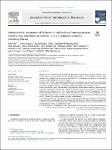Antimicrobial resistance of Escherichia coli isolates from outpatient urinary tract infections in women in six European countries including Russia
Ny, Sofia
Edquist, Petra
Dumpis, Uga
Gröndahl-Yli-Hannuksela, Kirsi
Hermes, Julia
Kling, Anna-Maria
Klingeberg, Anja
Kozlov, Roman
Källman, Owe
Lis, Danuta O.
Pomorska-Wesołowska, Monika
Saule, Mära
Tegmark Wisell, Karin
Vuopio, Jaana
Palagin, Ivan
NoDARS UTIStudy Group
Objectives
In the Northern Dimension Antibiotic Resistance Study (NoDARS), Finland, Germany, Latvia, Poland, Russia and Sweden collected urine samples from outpatient women (aged 18–65 years) with symptoms of uncomplicated urinary tract infection (UTI) to investigate the levels of antimicrobial resistance (AMR) among Escherichia coli isolates.
Methods
A total of 775 E. coli isolates from 1280 clinical urine samples were collected from October 2015 to January 2017. Antimicrobial susceptibility testing was performed and the results were interpreted according to European Committee on Antimicrobial Susceptibility Testing (EUCAST) criteria.
Results
Overall AMR rates to the commonly used antibiotics nitrofurantoin, fosfomycin and mecillinam (except for Germany that was missing a result for mecillinam) were 1.2%, 1.3% and 4.1%, respectively. The highest overall resistance rates were determined for ampicillin (39.6%), trimethoprim (23.8%), trimethoprim/sulfamethoxazole (22.4%), amoxicillin/clavulanic acid (16.7%) and ciprofloxacin (15.1%), varying significantly between countries. The rate of extended-spectrum β-lactamase (ESBL) production was 8.7%. None of the isolates showed resistance to meropenem.
Conclusions
In most cases, low AMR rates were detected against the first-line antibiotics recommended in national UTI treatment guidelines, giving support to their future use. These results also support the European Association of Urology guidelines stating that nitrofurantoin, fosfomycin and mecillinam are viable treatment options for uncomplicated UTI.

